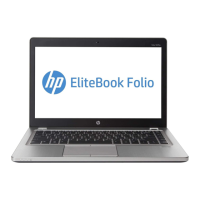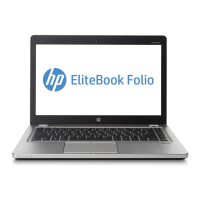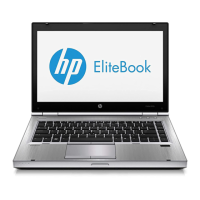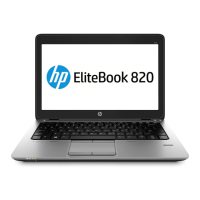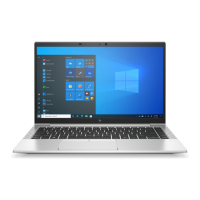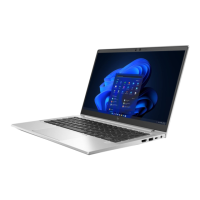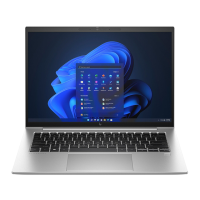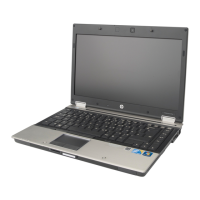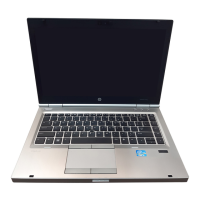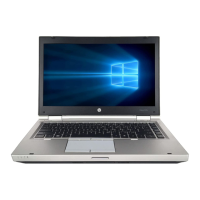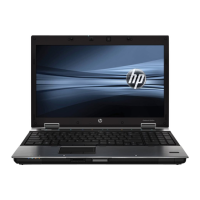
Do you have a question about the HP Elitebook 9480m and is the answer not in the manual?
| Form factor | Clamshell |
|---|---|
| Product type | Laptop |
| Product color | Black, Silver |
| Country of origin | China |
| Intel segment tagging | Enterprise |
| Memory slots | 2x SO-DIMM |
| Internal memory | 8 GB |
| Memory clock speed | 1600 MHz |
| Memory form factor | SO-DIMM |
| Internal memory type | DDR3L-SDRAM |
| Maximum internal memory | 16 GB |
| Memory layout (slots x size) | 1 x 8 GB |
| HDD speed | 7200 RPM |
| HDD interface | SATA |
| Storage media | HDD |
| Optical drive type | No |
| Card reader integrated | Yes |
| Total storage capacity | 500 GB |
| Compatible memory cards | MicroSD (TransFlash), MicroSDHC, MicroSDXC |
| Number of HDDs installed | 1 |
| Display surface | Matt |
| Display diagonal | 14 \ |
| Display resolution | 1600 x 900 pixels |
| Native aspect ratio | 16:9 |
| On-board graphics card ID | 0xA16 |
| Discrete graphics card model | Not available |
| On-board graphics card model | Intel® HD Graphics 4400 |
| On-board graphics card family | Intel® HD Graphics |
| Maximum on-board graphics card memory | 1.74 GB |
| On-board graphics card base frequency | 200 MHz |
| On-board graphics card dynamic frequency (max) | 1100 MHz |
| Number of built-in speakers | 2 |
| Video capturing speed | 30 fps |
| Front camera resolution | 1280 x 720 pixels |
| Wi-Fi standards | Wi-Fi 5 (802.11ac) |
| Ethernet LAN data rates | 10, 100, 1000 Mbit/s |
| Charging port type | DC-in jack |
| USB 2.0 ports quantity | 0 |
| Number of SATA III connectors | 4 |
| USB 3.2 Gen 1 (3.1 Gen 1) Type-A ports quantity | 3 |
| Sustainability certificates | ENERGY STAR |
| Operating shock | 40 G |
| Operating altitude | -15.24 - 3048 m |
| Non-operating shock | 200 G |
| Operating vibration | 0.75 G |
| Non-operating altitude | -15.24 - 12192 m |
| Non-operating vibration | 1.5 G |
| Storage temperature (T-T) | -20 - 60 °C |
| Operating temperature (T-T) | 0 - 35 °C |
| Storage relative humidity (H-H) | 5 - 95 % |
| Operating relative humidity (H-H) | 10 - 90 % |
| Battery capacity | 52 Wh |
| AC adapter power | 45 W |
| AC adapter output voltage | 19.5 V |
| Pointing device | Touchpad |
| Bus type | DMI2 |
| Stepping | D0 |
| Tjunction | 100 °C |
| Processor cache | 3 MB |
| System bus rate | 5 GT/s |
| Processor family | Intel® Core™ i5 |
| Processor series | Intel Core i5-4300 Mobile series |
| Processor socket | BGA 1168 |
| Processor codename | Haswell |
| Processor frequency | 2 GHz |
| Processor cache type | Smart Cache |
| Processor lithography | 22 nm |
| Processor manufacturer | Intel |
| Processor front side bus | - MHz |
| PCI Express slots version | 2.0 |
| Processor boost frequency | 3 GHz |
| Processor operating modes | 64-bit |
| PCI Express configurations | 4x1, 2x4 |
| Thermal Design Power (TDP) | 15 W |
| Maximum number of PCI Express lanes | 12 |
| Operating system installed | Windows 7 Professional |
| Processor code | SR1EE |
| Processor ARK ID | 80343 |
| Intel TSX-NI version | 0.00 |
| Processor package size | 40 x 24 x 1.5 mm |
| Intel ME Firmware Version | 9.5 |
| Supported instruction sets | AVX 2.0, SSE4.1, SSE4.2 |
| Intel Identity Protection Technology version | 1.00 |
| Depth | 231 mm |
|---|---|
| Width | 338 mm |
| Height | 18.9 mm |
| Weight | 1610 g |
Locates resources for product details, how-to information, and more.
Identifies components located on the right side of the computer.
Identifies components located on the left side of the computer.
Identifies components related to the computer display.
Identifies components located on the top surface of the computer.
Explains the status lights on the computer and their meanings.
Identifies physical buttons, speakers, and fingerprint reader.
Explains the function of various keys on the keyboard.
Identifies components located on the bottom surface of the computer.
Identifies components located on the front surface of the computer.
Guides on connecting to wireless local area networks (WLANs).
Explains how to control wireless devices using buttons or OS controls.
Details on accessing wireless local area networks.
Information on using wireless wide area network connectivity.
Steps for managing SIM cards for mobile broadband.
Connecting and using Bluetooth devices for personal area networks.
Guides on establishing a wired network connection.
Instructions for connecting to a wired LAN.
Overview of using TouchPad, pointing stick, and external mice.
Detailed guide to TouchPad navigation, gestures, and controls.
Keyboard functions, hot keys, and numeric keypads.
Managing audio settings and connecting audio devices.
How to connect external speakers to the computer.
Controlling audio volume levels using buttons or hot keys.
Connecting audio input/output devices like headphones and mics.
Verifying audio playback and recording functionality.
Using the integrated webcam for video capture and conferencing.
Information on video output and display options.
Connecting external displays via the VGA port.
Connecting external displays via the DisplayPort.
Wireless display connection methods.
Proper procedures for powering off the computer.
Configuring power settings for efficiency and battery life.
Utilizing sleep and hibernation modes to conserve power.
Managing quick resume from inactivity.
How to put the computer into and out of Sleep mode.
Configuring and using hibernation for power saving.
Monitoring power usage and adjusting settings.
Securing the computer upon waking from sleep or hibernation.
Information on battery status, charging, and replacement.
How to use memory card readers and supported formats.
Steps to insert a memory card into the reader.
Steps to safely remove a memory card.
Information on using smart cards and their security features.
How to insert a smart card into the reader.
How to remove a smart card from the reader.
Connecting and using USB devices.
Steps to connect a USB device to the computer.
Steps to safely remove a USB device.
Connecting external accessories like drives and docking stations.
Connecting external storage drives via USB.
Connecting the computer to a docking station.
Precautions for handling computer drives safely.
Information on utilizing hard disk drives.
Cache technology for performance enhancement.
Accessing the hard drive by removing the cover.
Reattaching the hard drive cover after access.
Procedures for replacing or upgrading the hard drive.
Steps to remove a hard drive from the bay.
Steps to install a hard drive into the bay.
Optimizing hard drive efficiency.
Consolidating fragmented files for performance.
Freeing up disk space by removing temporary files.
Protecting the hard drive during movement.
Checking the status of hard drive protection.
Overview of security features for data protection.
Setting and managing passwords for system security.
Configuring passwords within the Windows operating system.
Setting passwords in the system BIOS for access control.
Creating, changing, or deleting BIOS administrator passwords.
Setting up hard drive protection passwords.
Procedures for setting DriveLock passwords.
How to unlock a drive with a DriveLock password.
Modifying existing DriveLock passwords.
Disabling DriveLock security for a drive.
Enabling automatic drive locking for multi-user environments.
Accessing drives with automatic locking enabled.
Disabling automatic drive locking.
Protecting the computer against viruses and malware.
Configuring network firewalls for protection.
Keeping system software updated for security.
Utilizing HP's security management software.
Physically securing the computer to a fixed object.
Using biometric authentication for login.
Finding the fingerprint sensor on the computer.
Procedures for upgrading or replacing RAM modules.
Creating backups of data and system for recovery.
Restoring the computer from failure or instability.
Utilizing built-in Windows tools for data recovery.
Using the F11 key for system recovery.
Recovering the system using Windows installation media.
Resetting Windows to a fresh state or removing personal data.
Reinstalling HP software and drivers.
Navigating and configuring BIOS settings for system operation.
Procedures for checking and installing BIOS updates.
Managing boot device order and startup options.
Running hardware diagnostic tests and preparing diagnostic tools.
Ways to get help from HP support via chat, email, or phone.
Information about computer identification labels for support.
Details on the computer's power requirements and ratings.
Recommended environmental conditions for computer operation.
Steps to prepare the computer before traveling or shipping.
Links and contacts for support and help.
Troubleshooting startup failures and blank screens.
Resolving abnormal software behavior and system unresponsiveness.
Troubleshooting network, device, and disc playback problems.
Resolving problems encountered during optical disc burning.
Precautions to prevent damage from static electricity.
